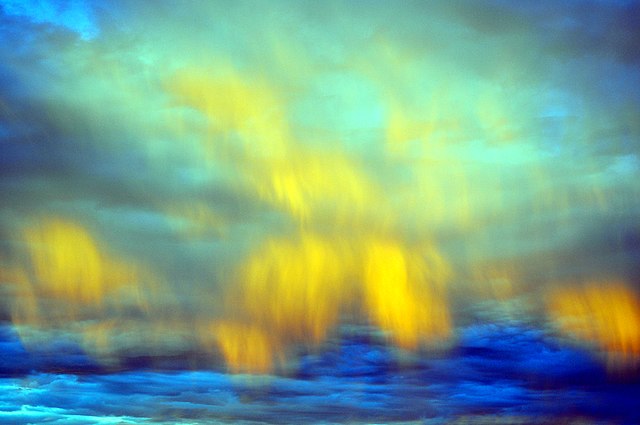In atmospheric science, the thermal wind is the vector difference between the geostrophic wind at upper altitudes minus that at lower altitudes in the atmosphere. It is the hypothetical vertical wind shear that would exist if the winds obey geostrophic balance in the horizontal, while pressure obeys hydrostatic balance in the vertical. The combination of these two force balances is called thermal wind balance, a term generalizable also to more complicated horizontal flow balances such as gradient wind balance.
Jet streams (shown in pink) are well-known examples of thermal wind. They arise from the horizontal temperature gradients between the warm tropics and the colder polar regions.
The geostrophic wind on different isobaric levels in a barotropic atmosphere (a) and in a baroclinic atmosphere (b). The blue portion of the surface denotes a cold region while the orange portion denotes a warm region. This temperature structure is restricted to the surface in (a) but extends through the depth of the fluid in (b). The dotted lines enclose isobaric surfaces which remain at constant slope with increasing height in (a) and increase in slope with height in (b). Pink arrows illustrate the direction and amplitude of the horizontal wind. Only in the baroclinic atmosphere (b) do these vary with height. Such variation illustrates the thermal wind.
In (a), cold advection is occurring, so the thermal wind causes the geostrophic wind to rotate counterclockwise (for the northern hemisphere) with height. In (b), warm advection is occurring, so the geostrophic wind rotates clockwise with height.
Wind shear, sometimes referred to as wind gradient, is a difference in wind speed and/or direction over a relatively short distance in the atmosphere. Atmospheric wind shear is normally described as either vertical or horizontal wind shear. Vertical wind shear is a change in wind speed or direction with a change in altitude. Horizontal wind shear is a change in wind speed with a change in lateral position for a given altitude.
Cirrus uncinus ice crystal plumes showing high-level wind shear, with changes in wind speed and direction
Down draft winds with associated virga allow these clouds in the eastern sky at civil twilight to mimic aurora borealis in the Mojave desert.
Microburst schematic from NASA. The direction of travel is downward until the air current hits ground level, at which point it spreads outward in all directions. The wind regime in a microburst is completely opposite to a tornado.[citation needed]
Strong wind shear in the high troposphere forms the anvil-shaped top of this mature cumulonimbus cloud, or thunderstorm.







